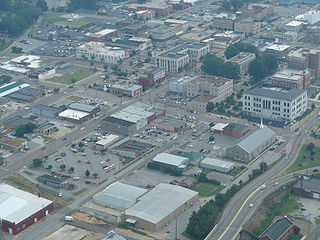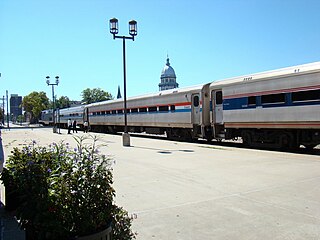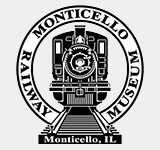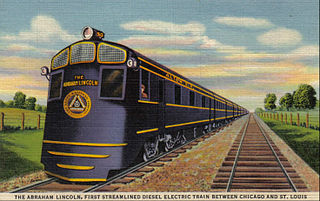
Jackson is a city in and the county seat of Madison County, Tennessee, United States. Located 70 miles (110 km) east of Memphis, it is a regional center of trade for West Tennessee. Its total population was 68,205 as of the 2020 United States census. Jackson is the primary city of the Jackson, Tennessee metropolitan area, which is included in the Jackson-Humboldt, Tennessee combined statistical area. Jackson is Madison County's largest city, and the second-largest city in West Tennessee after Memphis. It is home to the Tennessee Supreme Court's courthouse for West Tennessee, as Jackson was the major city in the west when the court was established in 1834.

The Illinois Central Railroad, sometimes called the Main Line of Mid-America, was a railroad in the Central United States. Its primary routes connected Chicago, Illinois, with New Orleans, Louisiana, and Mobile, Alabama, and thus, the Great Lakes to the Gulf of Mexico. Another line connected Chicago west to Sioux City, Iowa (1870), while smaller branches reached Omaha, Nebraska (1899) from Fort Dodge, Iowa, and Sioux Falls, South Dakota (1877), from Cherokee, Iowa. The IC also ran service to Miami, Florida, on trackage owned by other railroads.

The Ann Rutledge was a passenger train service operated by Amtrak running between St. Louis, Missouri, and Kansas City, Missouri, as part of the Missouri Services brand. In 2009 Amtrak consolidated the Ann Rutledge, Kansas City Mule, and the St. Louis Mule under the new name Missouri River Runner.

The EMD SD40 is an American 6-axle diesel-electric locomotive built by General Motors Electro-Motive Division between January 1966 and August 1972. 1,268 locomotives were built between 1966 and 1972. In 1972, an improved version with new electronics was developed and marketed as a new locomotive, the SD40-2.

The Central of Georgia Railway started as the Central Rail Road and Canal Company in 1833. As a way to better attract investment capital, the railroad changed its name to Central Rail Road and Banking Company of Georgia. This railroad was constructed to join the Macon and Western Railroad at Macon, Georgia, in the United States, and run to Savannah. This created a rail link from Chattanooga, on the Tennessee River, to seaports on the Atlantic Ocean. It took from 1837 to 1843 to build the railroad from Savannah to the eastern bank of the Ocmulgee River at Macon; a bridge into the city was not built until 1851.

The Alton Railroad was the final name of a railroad linking Chicago to Alton, Illinois; St. Louis, Missouri; and Kansas City, Missouri. Its predecessor, the Chicago and Alton Railroad, was purchased by the Baltimore and Ohio Railroad in 1931 and was controlled until 1942 when the Alton was released to the courts. On May 31, 1947, the Alton Railroad was merged into the Gulf, Mobile and Ohio Railroad. Jacob Bunn had been one of the founding reorganizers of the Chicago & Alton Railroad Company during the 1860s.
The Midnight Special was the name of a passenger train formerly operated by the Chicago and Alton Railroad and its successor, the Gulf, Mobile and Ohio Railroad. The train departed Union Station in St. Louis, Missouri, at 11:30 p.m. nightly and arrived at Union Station in Chicago, Illinois, at 7 a.m. the following day. In the heyday of overnight travel, from 1920 through the end of World War II, the Midnight Specials were all Pullman Co. trains carrying no coaches and as many as 12 sleeping cars.

Springfield station is a brick railroad depot in Springfield, Illinois, the state capital. It is at mile 185 on Amtrak's Illinois and Missouri Route. As of 2007, it is served by five daily round trips each way: the daily Texas Eagle, and four daily Lincoln Service frequencies. It will be replaced by the Springfield-Sangamon Transportation Center, which is currently under construction, and expected to open in 2027.

The Mobile and Ohio Railroad was a railroad in the Southern U.S. The M&O was chartered in January and February 1848 by the states of Alabama, Kentucky, Mississippi, and Tennessee. It was planned to span the distance between the seaport of Mobile, Alabama and the Ohio River near Cairo, Illinois. On September 13, 1940, it was merged with the Gulf, Mobile and Northern Railroad to form the Gulf, Mobile and Ohio Railroad.
The Gulf, Mobile and Northern Railroad was a railroad in the Southern United States. The first World War had forced government operation upon the company; and in 1919, when it became once more a free agent, it chose Isaac B. Tigrett to chart its new course. Tigrett, a native of Jackson, Tennessee, was president of the GM&N from 1920 and of its successor, the GM&O, from 1938 to 1952, and oversaw the development of the road from a nearly bankrupt operation into a thriving success. He was the great-uncle of Hard Rock Cafe founder Isaac Tigrett, also a native of Jackson.

The Monticello Railway Museum is a non-profit railroad museum located in Monticello, Illinois, about 18 miles west of Champaign, Illinois. It is home to over 100 pieces of railroad equipment, including several restored diesel locomotives and cars.

Springfield Union Station is a former train station in Springfield, Illinois, which is currently part of the Abraham Lincoln Presidential Library and Museum. The Richardson Romanesque-style station is located at 500 East Madison Street in downtown Springfield, adjacent to the Lincoln Presidential Library. Springfield Union Station opened in 1898 and served trains until 1971, when Amtrak consolidated its services at the former Chicago & Alton depot three blocks west.

The Abraham Lincoln was a named passenger train operated by the Baltimore and Ohio Railroad from 1935 into the 1960s. The Abe Lincoln ran between Chicago and St. Louis on the B&O's subsidiary Alton Railroad. The train later passed to the Gulf, Mobile and Ohio Railroad, and then finally to Amtrak, which retained the name until 1978. Service between Chicago and St. Louis is now known by the umbrella term Lincoln Service. This train was the first streamlined passenger service to travel the 284 miles between Chicago and St. Louis, with Joliet, Bloomington-Normal, Springfield and Alton in between. Passengers can get a glimpse of the Mississippi River between Alton and St. Louis.

The Gulf, Mobile and Northern Railroad Rebels were lightweight, streamlined diesel-electric trains built by American Car and Foundry. The first two trains, purchased in 1935, provided service over the roughly 450 miles (720 km) between New Orleans, Louisiana, and Jackson, Tennessee. The third train, purchased in 1937, allowed service to be added between Jackson and Mobile, Alabama. Unlike other earlier diesel streamliners, these trains were not articulated, as their normal operation required adding and removing cars from the consist.
The following is a brief history of the North American rail system, mainly through major changes to Class I railroads, the largest class by operating revenue.

The Ripley & New Albany Railroad is a 27-mile long (43 km) shortline railroad that runs from New Albany to Falkner, Mississippi, and previously extended from Houston, Mississippi, to Middleton, Tennessee, along former Gulf, Mobile and Ohio Railroad trackage. RNA interchanges with the BNSF Railway in New Albany, Mississippi. It primarily hauls lumber products and Oil-Dri.

The Gulf Coast Rebel was a streamlined passenger train operated by the Gulf, Mobile and Ohio Railroad (GM&O) between St. Louis, Missouri and Mobile, Alabama. It operated from 1940 to 1958. Unlike the similarly named Rebels, the Gulf Coast Rebel used conventional locomotive-pulled equipment. The train was the last GM&O service south of St. Louis, Missouri when it was discontinued in 1958.

The Tanglefoot Trail is an asphalt-covered rail trail in northeastern Mississippi. Ranging 43.6 miles (70.2 km) in the right-of-way of the Ripley and New Albany Railroad, it is the longest rail-trail in the state. It runs through three counties and is located within the Mississippi Hills National Heritage Area.
The Mobile, Jackson and Kansas City Railroad Company (MJ&KC) was established in 1890 in Mobile, Alabama. By 1898 the line reached the Pascagoula River at Merrill, Mississippi. The railroad had 50 miles of trackage in 1900 and reached Hattiesburg, Mississippi, via the Bonhomie & Hattiesburg Southern Railroad in 1902.


















